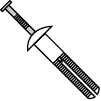How to hang stuff up
If you are going to attach to concrete, brick, stucco and other cementious materials you simply cannot beat the concrete screw.
Concrete screws provide fast, secure anchoring, utilizing a hardened screw with specially fashioned high and low threads that cut into the properly sized hole and thread into concrete, masonry, brick, block, etc.
Installation is accomplished through the use of specially designed carbide bits (one provided free per box), and becomes an even faster operation when used with the concrete screw drive tool. The concrete screw system eliminates the need for plastic or lead anchors in medium and light duty applications, and can be removed if desired without excessive damage to the surrounding surface.
There are several brands but the best known is "Tapcon" and they are available at most hardware stores,building centers and lumber yards.

To install them, you need only a 3/16- or 1/4-in. carbide masonry bit (check the instructions) and an ordinary drill with adjustable speed (high-speed settings will shorten the life of the masonry bits).
Buy screws that are long enough to sink at least 1 in. deep into the concrete.
a few other types of fastening devices are

The Molly Bolt-For fastening into a hollow wall area such as drywall, they are best for heavy objects like mirrors
Plastic Anchors

These are the easiest but only good for light items like small pictures. Again for hollow walls like drywall. simple to use, punch a small hole the size of the plastic anchor so that it fits in snug then use the correct screw (normally come in the same package) and screw in expanding the back side which flares out on the back side.
A very similar type fastener is made out of lead and can be used in masonry, its called, "lead anchor"
Toggle Bolt

Toggle bolts are also for hollow walls and heavy objects. First the hole,the "wings" are pushed into the hole, they expand once inside the wall and as you tighten in on the screw the wings are pulled up tight against the backside of the wall.
The nail-in fastener.

These are real handy for attaching a flat item to a wall like the side rail for a tub enclosure, or a hanger with a hole in it. simply make a hole the size of the fastener, put the item to be attached over the hole,insert the "nail-in" and tap on the builtin nail which expands the back side. Again, for hollow walls. The disadvantage to these is that removing them is not something you want to do often, the hole becomes worthless and you need to patch it.
|
Need Supplies?
Shopping
Directory
Next time you Paint You Can also INSULATE!
Here's How
Get Your How-To
Books
Videos
and Tools at

|

